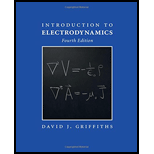
Introduction to Electrodynamics
4th Edition
ISBN: 9781108420419
Author: David J. Griffiths
Publisher: Cambridge University Press
expand_more
expand_more
format_list_bulleted
Question
Chapter 1.6, Problem 1.61P
(a)
To determine
To show:
(b)
To determine
To show:
(c)
To determine
To show:
(d)
To determine
To show:
(e)
To determine
To show:
Expert Solution & Answer
Want to see the full answer?
Check out a sample textbook solution
Students have asked these similar questions
No chatgpt pls will upvote
No chatgpt pls will upvote
No chatgpt pls will upvote
Chapter 1 Solutions
Introduction to Electrodynamics
Ch. 1.1 - Using the definitions in Eqs. 1.1 and 1.4, and...Ch. 1.1 - Prob. 1.2PCh. 1.1 - Prob. 1.3PCh. 1.1 - Prob. 1.4PCh. 1.1 - Prob. 1.5PCh. 1.1 - Prob. 1.6PCh. 1.1 - Prob. 1.7PCh. 1.1 - Prob. 1.8PCh. 1.1 - Prob. 1.9PCh. 1.1 - Prob. 1.10P
Ch. 1.2 - Prob. 1.11PCh. 1.2 - The height of a certain hill (in feet) is given by...Ch. 1.2 - Prob. 1.13PCh. 1.2 - Prob. 1.14PCh. 1.2 - Prob. 1.15PCh. 1.2 - Prob. 1.16PCh. 1.2 - Prob. 1.17PCh. 1.2 - Prob. 1.18PCh. 1.2 - Prob. 1.19PCh. 1.2 - Prob. 1.20PCh. 1.2 - Prob. 1.21PCh. 1.2 - Prob. 1.22PCh. 1.2 - Prob. 1.23PCh. 1.2 - Prob. 1.24PCh. 1.2 - Prob. 1.25PCh. 1.2 - Prob. 1.26PCh. 1.2 - Prob. 1.27PCh. 1.2 - Prob. 1.28PCh. 1.3 - Prob. 1.29PCh. 1.3 - Prob. 1.30PCh. 1.3 - Prob. 1.31PCh. 1.3 - Prob. 1.32PCh. 1.3 - Prob. 1.33PCh. 1.3 - Prob. 1.34PCh. 1.3 - Prob. 1.35PCh. 1.3 - Prob. 1.36PCh. 1.4 - Prob. 1.37PCh. 1.4 - Express the unit vectors in terms of (that is,...Ch. 1.4 - Prob. 1.39PCh. 1.4 - Prob. 1.40PCh. 1.4 - Prob. 1.41PCh. 1.4 - Prob. 1.42PCh. 1.4 - Prob. 1.43PCh. 1.5 - Evaluate the following integrals:
(a)
(b)
(c)...Ch. 1.5 - Prob. 1.45PCh. 1.5 - (a) Show that .
[Hint: Use integration by...Ch. 1.5 - Prob. 1.47PCh. 1.5 - Prob. 1.48PCh. 1.5 - Prob. 1.49PCh. 1.6 - (a) Let and . Calculate the divergence and curl...Ch. 1.6 - Prob. 1.51PCh. 1.6 - Prob. 1.52PCh. 1.6 - Prob. 1.53PCh. 1.6 - Prob. 1.54PCh. 1.6 - Prob. 1.55PCh. 1.6 - Prob. 1.56PCh. 1.6 - Prob. 1.57PCh. 1.6 - Prob. 1.58PCh. 1.6 - Prob. 1.59PCh. 1.6 - Prob. 1.60PCh. 1.6 - Prob. 1.61PCh. 1.6 - Prob. 1.62PCh. 1.6 - Prob. 1.63PCh. 1.6 - Prob. 1.64P
Knowledge Booster
Similar questions
- air is pushed steadily though a forced air pipe at a steady speed of 4.0 m/s. the pipe measures 56 cm by 22 cm. how fast will air move though a narrower portion of the pipe that is also rectangular and measures 32 cm by 22 cmarrow_forwardNo chatgpt pls will upvotearrow_forward13.87 ... Interplanetary Navigation. The most efficient way to send a spacecraft from the earth to another planet is by using a Hohmann transfer orbit (Fig. P13.87). If the orbits of the departure and destination planets are circular, the Hohmann transfer orbit is an elliptical orbit whose perihelion and aphelion are tangent to the orbits of the two planets. The rockets are fired briefly at the depar- ture planet to put the spacecraft into the transfer orbit; the spacecraft then coasts until it reaches the destination planet. The rockets are then fired again to put the spacecraft into the same orbit about the sun as the destination planet. (a) For a flight from earth to Mars, in what direction must the rockets be fired at the earth and at Mars: in the direction of motion, or opposite the direction of motion? What about for a flight from Mars to the earth? (b) How long does a one- way trip from the the earth to Mars take, between the firings of the rockets? (c) To reach Mars from the…arrow_forward
- No chatgpt pls will upvotearrow_forwarda cubic foot of argon at 20 degrees celsius is isentropically compressed from 1 atm to 425 KPa. What is the new temperature and density?arrow_forwardCalculate the variance of the calculated accelerations. The free fall height was 1753 mm. The measured release and catch times were: 222.22 800.00 61.11 641.67 0.00 588.89 11.11 588.89 8.33 588.89 11.11 588.89 5.56 586.11 2.78 583.33 Give in the answer window the calculated repeated experiment variance in m/s2.arrow_forward
- How can i solve this if n1 (refractive index of gas) and n2 (refractive index of plastic) is not known. And the brewsters angle isn't knownarrow_forward2. Consider the situation described in problem 1 where light emerges horizontally from ground level. Take k = 0.0020 m' and no = 1.0001 and find at which horizontal distance, x, the ray reaches a height of y = 1.5 m.arrow_forward2-3. Consider the situation of the reflection of a pulse at the interface of two string described in the previous problem. In addition to the net disturbances being equal at the junction, the slope of the net disturbances must also be equal at the junction at all times. Given that p1 = 4.0 g/m, H2 = 9.0 g/m and Aj = 0.50 cm find 2. A, (Answer: -0.10 cm) and 3. Ay. (Answer: 0.40 cm)please I need to show all work step by step problems 2 and 3arrow_forward
arrow_back_ios
SEE MORE QUESTIONS
arrow_forward_ios
Recommended textbooks for you
 Classical Dynamics of Particles and SystemsPhysicsISBN:9780534408961Author:Stephen T. Thornton, Jerry B. MarionPublisher:Cengage Learning
Classical Dynamics of Particles and SystemsPhysicsISBN:9780534408961Author:Stephen T. Thornton, Jerry B. MarionPublisher:Cengage Learning

Classical Dynamics of Particles and Systems
Physics
ISBN:9780534408961
Author:Stephen T. Thornton, Jerry B. Marion
Publisher:Cengage Learning